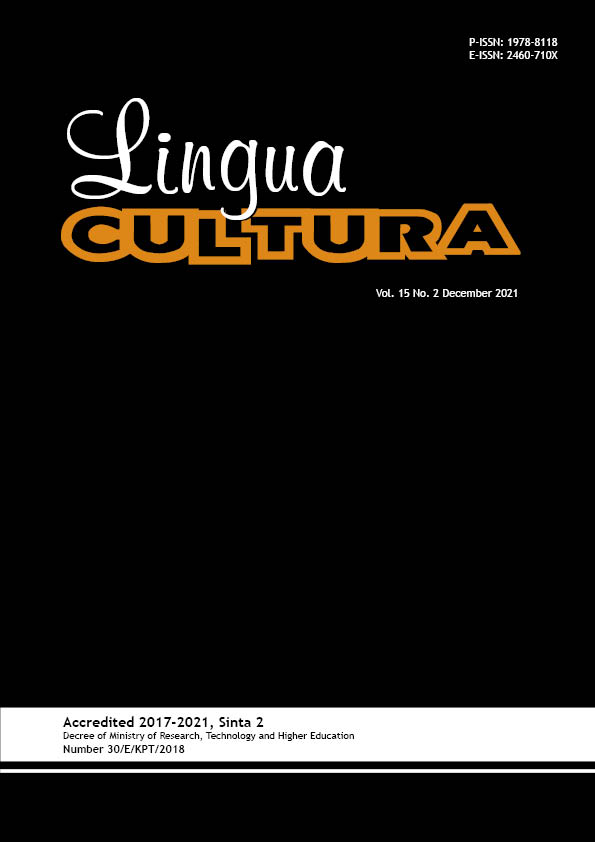Linguistic Creativity of the Indonesian for Foreign Speakers (BIPA) Students at the Morphological, Syntactic, and Semantic Levels
DOI:
https://doi.org/10.21512/lc.v15i2.7613Keywords:
linguistic creativity, BIPA, Indonesian language, foreign speakersAbstract
The research aimed to describe the forms of linguistic creativity of BIPA students at the morphological, syntactic, and semantic levels. The research method used was descriptive qualitative with content analysis techniques. The research data were 78 sentences written by BIPA students at Bina Nusantara University academic year 2020/2021. The results show that BIPA students’ sentences have linguistic creativity in the form of the morphological, syntactic, and semantic levels sentences. At the morphological level, the process of linguistic creativity in words is carried out by (1) inserting foreign terms into sentences, (2) using non-standard words, and (3) abbreviating words. While in phrases, linguistic creativity is done by (1) reversing the structure of the phrase, (2) forming nominal phrases with less common word pairs, and (3) forming nominal phrases by incorporating elements of student culture. At the syntactic level, linguistic creativity is carried out in the form of compiling compound sentences with the expansion of descriptions, expansion of objects, expansion of subjects, and expansion of predicates. At the semantic level, linguistic creativity is manifested in the form of the figure of speech: personification, simile, hyperbole, repetition, and metaphor.
References
Chaer, A. (2015). Morfologi bahasa Indonesia: Pendekatan proses. Jakarta: Rineka Cipta.
Chen, C. W. (2018). Integrating creativity into an English as a foreign language reading classroom. TESOL Journal, 9(4), 1-5. https://doi.org/10.1002/tesj.384.
Choi, J. (2016). Creative critically multilingual texts. In R. H. Jones & J. C. Richards (Eds.), Creativity in Language Teaching Perspective from Research and Practice. New York: Routledge.
Ellis, R. (2016). In R. H. Jones & J. C. Richards (eds), Creativity and Language Learning. New York: Routledge.
Gani, S., & Arsyad, B. (2018). Kajian teoritis struktur internal bahasa (Fonologi, morfologi, sintaksis, dan semantik). Jurnal Bahasa Dan Sastra Arab, 7(1), 1-20.
Inderasari, E., & Agustina, T. (2017). Pembelajaran bahasa Indonesia pada mahasiswa asing dalam program BIPA IAIN Surakarta. Jurnal Pendidikan Bahasa Dan Sastra Indonesia, 6(2), 6-15. https://doi.org/10.15294/jpbsi.v6i2.20192.
Jiang, N. (2018). Second language processing. Families, Systems and Health, 32(2), 248-249. https://doi.org/10.1037/fsh0000050.
Jones, R. H. (2020). Creativity in language learning and teaching: Translingual practices and transcultural identities. Applied Linguistics Review, 11(4), 535-550. https://doi.org/10.1515/applirev-2018-0114.
Kiose, М. I. (2021). Linguistic creativity and discourse profiles of English language children’s novels. Russian Journal of Linguistics, 25(1), 147-164. https://doi.org/10.22363/2687-0088-2021-25-1-147-164.
Kusmana, A. (2014). Pengembangan materi ajar semantik. Lentera Pendidikan: Jurnal Ilmu Tarbiyah dan Keguruan, 17(1), 1-17. https://doi.org/10.24252/lp.2014v17n1a1.
Kusmiatun, A., Suyitno, I., Widodo, H. S., & Basuki, I. A. (2017). Identifying features of Indonesian for Speakers of Other Languages (BIPA) learning for academic purposes. International Journal of Social Sciences & Educational Studies, 3(4), 197-207. https://doi.org/10.23918/ijsses.v3i4p197.
Lopez, L. G. M. (2019). The Indonesian language and its potential to become an international language. Proceedings of the Third International Conference of Arts, Language and Culture (ICALC 2018). Pp 278-280. https://doi.org/10.2991/icalc-18.2019.40.
Moleong L. J. (2004). Metodologi penelitian kualitatif. Bandung: Remaja Rosdakarya.
Mukalel, J. C. (2003). Psychology of language learning. Delhi: Arora Offset Press.
Naufalia, A. (2019). Kesalahan struktur fungsi sintaksis dalam konstruksi kalimat pada tuturan pemelajar BIPA tingkat awal. Seminar Internasional Riksa Bahasa XIII. Bandung, Indonesia. Pp 165-174.
Ningrum, R. K., Waluyo, H., & Winari, R. (2017). BIPA sebagai upaya internasionalisasi universitas di Indonesia. Education and Language International Conference Proceedings, 1(1), 726-732.
Novikova, I. A., Berisha, N. S., Novikov, A. L., & Shlyakhta, D. A. (2020). Creativity and personality traits as foreign language acquisition predictors in university linguistics students. Behavioral Sciences, 10(1), 4-7. https://doi.org/10.3390/bs10010035.
Pawlak, M., Mystkowska, A., & Wiertelak. (2018). Challenges of second and foreign language education in a globalized world: Studies in honor of Krystyna DrozÌdziaÅ‚-Szelest. USA: Springer.
Purba, A. (2013). Peranan lingkungan bahasa dalam pemerolehan bahasa kedua. Pena: Jurnal Pendidikan Bahasa dan Sastra, 3(1), 13-25.
Rahmawati, L. E., Suwandi, S., Saddhono, K., & Setiawan, B. (2019). Construction of test instrument to assess foreign student’s competence of Indonesian language through objective test. International Journal of Instruction, 12(4), 35-48. https://doi.org/10.29333/iji.2019.1243a.
Rus, D. (2020). Creative methodologies in teaching English for Engineering students. Procedia Manufacturing, 46, 337-343. https://doi.org/10.1016/j.promfg.2020.03.049.
Shoghi, S., & Ghonsooly, B. (2018). Learning a foreign language: A new path to enhancement of cognitive functions. Journal of Psycholinguistic Research, 47(1), 125-138. https://doi.org/10.1007/s10936-017-9518-7.
Tarmini, W., & Sulistyawati, R. (2019). Sintaksis bahasa Indonesia. Jakarta: Uhamka Press.
Yono, R. R. Y., & Mulyani, M. (2017). Majas dan citraan dalam novel ‚Kerling si Janda’ Kkarya Taufiqurrahman Al-Azizy. Seloka: Jurnal Pendidikan Bahasa dan Sastra Indonesia, 6(2), 200-207. https://doi.org/10.15294/seloka.v6i2.17286.
Downloads
Published
How to Cite
Issue
Section
License
Copyright (c) 2021 Rahmi Yulia Ningsih, Zainal Rafli, Endry Boeriswati

This work is licensed under a Creative Commons Attribution-ShareAlike 4.0 International License.
Authors who publish with this journal agree to the following terms:
a. Authors retain copyright and grant the journal right of first publication with the work simultaneously licensed under a Creative Commons Attribution License - Share Alike that allows others to share the work with an acknowledgment of the work's authorship and initial publication in this journal.
b. Authors are able to enter into separate, additional contractual arrangements for the non-exclusive distribution of the journal's published version of the work (e.g., post it to an institutional repository or publish it in a book), with an acknowledgment of its initial publication in this journal.
c. Authors are permitted and encouraged to post their work online (e.g., in institutional repositories or on their website) prior to and during the submission process, as it can lead to productive exchanges, as well as earlier and greater citation of published work.
USER RIGHTS
All articles published Open Access will be immediately and permanently free for everyone to read and download. We are continuously working with our author communities to select the best choice of license options, currently being defined for this journal as follows: Creative Commons Attribution-Share Alike (CC BY-SA)


















